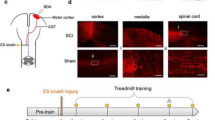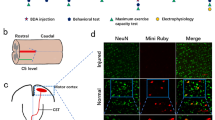Abstract
Assisted-treadmill training, may be helpful in promoting muscle mass preservation after incomplete spinal cord injury (SCI). However, biological mechanism involved in this process is still not fully understood. This study investigated the effects of locomotor treadmill training on muscle trophism mediated by protein kinase B (Akt)/mammalian target of rapamycin (mTOR)/p70 ribosomal protein S6 kinase (p70S6K) in paraplegic rats. Adult female Wistar rats underwent an incomplete thoracic SCI induced by compression using an aneurysm clip. After 7 days, injured animals started a 3-week locomotor treadmill training with body weight-support and manual step help. Soleus trophism was measured by muscle weight and transverse myofiber cross-sectional area (CSA). An enzyme-linked immunosorbent assay (ELISA) and western blot analysis were used to detect brain-derived neurotrophic factor (BDNF), tropomyosin-related kinase B (TrkB), Akt, mTOR and p70S6K in paretic soleus. Trained animals did not show locomotor improved, but present an increase in muscle weight and myofiber CSA. Furthermore, the levels of Akt, p70S6K phosphorylation, mTOR and TrkB receptor were increased by training in soleus. In contrast, muscle BDNF levels were significantly reduced after training. The results suggest locomotor treadmill training partially reverts/prevents soleus muscle hypotrophy in rats with SCI. Furthermore, this study provided the first evidence that morphological muscle changes were caused by Akt/mTOR/p70S6K signaling pathway and TrkB up-regulation, which may increase the sensitivity of muscle, reducing autocrine signaling pathway demand of BDNF for cell growth.




Similar content being viewed by others
References
Kocina P (1997) Body composition of spinal cord injured adults. Sports Med 23:48–60
Haisma JA, van der Woude LH, Stam HJ, Bergen MP, Sluis TA, Bussmann JB (2006) Physical capacity in wheelchair-dependent persons with a spinal cord injury: a critical review of the literature. Spinal Cord 44:642–652
Léger B, Cartoni R, Praz M, Lamon S, Dériaz O, Crettenand A et al (2006) Akt signalling through GSK-3beta, mTOR and Foxo1 is involved in human skeletal muscle hypertrophy and atrophy. J Physiol 576:923–933
Drummond MJ, Glynn EL, Lujan HL, Dicarlo SE, Rasmussen BB (2008) Gene and protein expression associated with protein synthesis and breakdown in paraplegic skeletal muscle. Muscle Nerve 37:505–513
Léger B, Senese R, Al-Khodairy AW, Dériaz O, Gobelet C, Giacobino JP et al (2009) Atrogin-1, MuRF1, and FoXO, as well as phosphorylated GSK-3beta and 4E-BP1 are reduced in skeletal muscle of chronic spinal cord-injured patients. Muscle Nerve 40:69–78
Sandri M (2008) Signaling in muscle atrophy and hypertrophy. Physiology 23:160–170
Bodine SC, Stitt TN, Gonzalez M, Kline WO, Stover GL, Bauerlein R et al (2001) Akt/mTOR pathway is a crucial regulator of skeletal muscle hypertrophy and can prevent muscle atrophy in vivo. Nat Cell Biol 3:1014–1019
Dreyer HC, Glynn EL, Lujan HL, Fry CS, DiCarlo SE, Rasmussen BB (2008) Chronic paraplegia-induced muscle atrophy downregulates the mTOR/S6K1 signaling pathway. J Appl Physiol 104:27–33
Dietz V, Harkema SJ (2004) Locomotor activity in spinal cord-injured persons. J Appl Physiol 96:1954–1960
Ilha J, da Cunha NB, Jaeger M, de Souza DF, Nascimento PS, Marcuzzo S et al (2011) Treadmill step training-induced adaptive muscular plasticity in a chronic paraplegia model. Neurosci Lett 492:170–174
Benito-Penalva J, Edwards DJ, Opisso E, Cortes M, Lopez-Blazquez R, Murillo N et al (2012) Gait training in human spinal cord injury using electromechanical systems: effect of device type and patient characteristics. Arch Phys Med Rehabil 93:404–412
Gómez-Pinilla F, Ying Z, Opazo P, Roy RR, Edgerton VR (2001) Differential regulation by exercise of BDNF and NT-3 in rat spinal cord and skeletal muscle. Eur J Neurosci 13:1078–1084
Dupont-Versteegden EE, Houlé JD, Dennis RA, Zhang J, Knox M, Wagoner G et al (2004) Exercise-induced gene expression in soleus muscle is dependent on time after spinal cord injury in rats. Muscle Nerve 29:73–81
Takei N, Kawamura M, Hara K, Yonezawa K, Nawa H (2001) Brain-derived neurotrophic factor enhances neuronal translation by activating multiple initiation processes: comparison with the effects of insulin. J Biol Chem 276:42818–42825
Takei N, Inamura N, Kawamura M, Namba H, Hara K, Yonezawa K et al (2004) Brain-derived neurotrophic factor induces mammalian target of rapamycin-dependent local activation of translation machinery and protein synthesis in neuronal dendrites. J Neurosci 24:9760–9769
Poon PC, Gupta D, Shoichet MS, Tator CH (2007) Clip compression model is useful for thoracic spinal cord injuries: histologic and functional correlates. Spine 32:2853–2859
Liu M, Stevens-Lapsley JE, Jayaraman A, Ye F, Conover C, Walter GA et al (2010) Impact of treadmill locomotor training on skeletal muscle IGF1 and myogenic regulatory factors in spinal cord injured rats. Eur J Appl Physiol 109:709–720
Basso DM, Beattie MS, Bresnahan JC (1995) A sensitive and reliable locomotor rating scale for open field testing in rats. J Neurotrauma 12:1–21
Fouad K, Metz GA, Merkler D, Dietz V, Schwab ME (2000) Treadmill training in incomplete spinal cord injured rats. Behav Brain Res 115:107–113
Marcuzzo S, Dutra MF, Stigger F, do Nascimento PS, Ilha J, Kalil-Gaspar PI et al (2008) Beneficial effects of treadmill training in a cerebral palsy-like rodent model: walking pattern and soleus quantitative histology. Brain Res 1222:129–140
Parkington JD, Siebert AP, LeBrasseur NK, Fielding RA (2003) Differential activation of mTOR signaling by contractile activity in skeletal muscle. Am J Physiol Regul Integr Comp Physiol 285:1086–1090
Gutu A, O’Shea EK (2013) Two antagonistic clock-regulated histidine kinases time the activation of circadian gene expression. Mol Cell 50:288–294
George A, Schmidt C, Weishaupt A, Toyka KV, Sommer C (1999) Serial determination of tumor necrosis factor-alpha content in rat sciatic nerve after chronic constriction injury. Exp Neurol 160:124–132
Bradford MM (1976) A rapid and sensitive method for the quantitation of microgram quantities of protein utilizing the principle of protein-dye binding. Anal Biochem 72:248–254
Hay N, Sonenberg N (2004) Upstream and downstream of mTOR. Genes Dev 18:1926–1945
Dutta C, Hadley EC (1995) The significance of sarcopenia in old age. J Gerontol A 50(Special Issue):1–4
Houle JD, Morris K, Skinner RD, Garcia-Rill E, Peterson CA (1999) Effects of fetal spinal cord tissue transplants and cycling exercise on the soleus muscle in spinalized rats. Muscle Nerve 22:846–856
Marques SA, Garcez VF, Del Bel EA, Martinez AM (2009) A simple, inexpensive and easily reproducible model of spinal cord injury in mice: morphological and functional assessment. J Neurosci Methods 177:183–193
Erschbamer MK, Pham TM, Zwart MC, Baumans V, Olson L (2006) Neither environmental enrichment nor voluntary wheel running enhances recovery from incomplete spinal cord injury in rats. Exp Neurol 201:154–164
Adams MM, Ditor DS, Tarnopolsky MA, Phillips SM, McCartney N, Hicks AL (2006) The effect of body weight-supported treadmill training on muscle morphology in an individual with chronic, motor-complete spinal cord injury: a case study. J Spinal Cord Med 29:167–171
Giangregorio LM, Hicks AL, Webber CE, Phillips SM, Craven BC, Bugaresti JM et al (2005) Body weight supported treadmill training in acute spinal cord injury: impact on muscle and bone. Spinal Cord 43:649–657
Giangregorio L, McCartney N (2006) Bone loss and muscle atrophy in spinal cord injury: epidemiology, fracture prediction, and rehabilitation strategies. J Spinal Cord Med 29:489–500
do Espírito Santo CC, Swarowsky A, Recchia TL, Lopes AP, Ilha J (2015) Is body weight-support treadmill training effective in increasing muscle trophism after traumatic spinal cord injury? A systematic review. Spinal Cord 53:176–181
Stewart BG, Tarnopolsky MA, Hicks AL, McCartney N, Mahoney DJ, Staron RS et al (2004) Treadmill training-induced adaptations in muscle phenotype in persons with incomplete spinal cord injury. Muscle Nerve 30:61–68
Stevens JE, Liu M, Bose P, O’Steen WA, Thompson FJ, Anderson DK et al (2006) Changes in soleus muscle function and fiber morphology with one week of locomotor training in spinal cord contusion injured rats. J Neurotrauma 23:1671–1681
Shields RK, Dudley-Javoroski S (2006) Musculoskeletal plasticity after acute spinal cord injury: effects of long-term neuromuscular electrical stimulation training. J Neurophysiol 95:2380–2390
Goodman CA, Frey JW, Mabrey DM, Jacobs BL, Lincoln HC, You JS et al (2011) The role of skeletal muscle mTOR in the regulation of mechanical load-induced growth. J Physiol 589:5485–5501
Baligand C, Chen YW, Ye F, Pandey SN, Lai SH, Liu M et al (2015) Transcriptional pathways associated with skeletal muscle changes after spinal cord injury and treadmill locomotor training. Biomed Res Int 2015:1–13
Kawasome H, Papst P, Webb S, Keller GM, Johnson GL, Gelfand EW et al (1998) Targeted disruption of p70(s6k) defines its role in protein synthesis and rapamycin sensitivity. Proc Natl Acad Sci USA 95:5033–5038
Baar K, Esser K (1999) Phosphorylation of p70(S6k) correlates with increased skeletal muscle mass following resistance exercise. Am J Physiol 276:120–127
Bolster DR, Kubica N, Crozier SJ, Williamson DL, Farrell PA, Kimball SR et al (2003) Immediate response of mammalian target of rapamycin (mTOR)-mediated signalling following acute resistance exercise in rat skeletal muscle. J Physiol 553:213–220
Ogborn DI, Gardiner PF (2010) Effects of exercise and muscle type on BDNF, NT-4/5, and TrkB expression in skeletal muscle. Muscle Nerve 41:385–391
Sakuma K, Akihiko Y (2011) The recent understanding of the neurotrophin’s role in skeletal muscle adaptation. Biomed Res Int 2011:1–12
Kulakowski SA, Parker SD, Personius KE (2011) Reduced TrkB expression results in precocious age-like changes in neuromuscular structure, neurotransmission, and muscle function. J Appl Physiol 111:844–852
Clow C, Jasmin BJ (2010) Brain-derived neurotrophic factor regulates satellite cell differentiation and skeltal muscle regeneration. Mol Biol Cell 21:2182–2190
Di Lieto A, Rantamäki T, Vesa L, Yanpallewar S, Antila H, Lindholm J et al (2012) The responsiveness of TrkB to BDNF and antidepressant drugs is differentially regulated during mouse development. PLoS ONE 7:1–11
Meyer-Franke A, Wilkinson GA, Kruttgen A, Hu M, Munro E, Hanson MG Jr et al (1998) Depolarization and cAMP elevation rapidly recruit TrkB to the plasma membrane of CNS neurons. Neuron 21:681–693
Huang SH, Wang J, Sui WH, Chen B, Zhang XY, Yan J et al (2013) BDNF-dependent recycling facilitates TrkB translocation to postsynaptic density during LTP via a Rab11-dependent pathway. J Neurosci 22:9214–9230
Acknowledgements
The authors are grateful to the undergraduate students, Amabile Weber, Jéssyca Vieira, Letícia Rosa and Nicolas Alexsander for their kind assistance in caring for the animals during the survival period.
Funding
This work was supported by grants from Conselho Nacional de Desenvolvimento Científico e Tecnológico (CNPq), Fundação de Amparo à Pesquisa e Inovação do Estado de Santa Catarina (FAPESC, TO 2013TR003379), and Coordenação de Aperfeiçoamento de Pessoal de Nível Superior (CAPES), Brazil. No competing financial interests exist.
Author information
Authors and Affiliations
Contributions
CCES: study concept and design, acquisition, analysis and interpretation of data and further drafted the manuscript. AM and GRF: acquisition and interpretation of data (notably behavioral analysis), and revision of the manuscript. FB: acquisition and interpretation of data (notably ELISA analysis), and revision of the manuscript. MPC, DDS and ALSR: acquisition and interpretation of data (notably Western blot analysis), and critical revision of the manuscript. ARSS, AS and JI: study concept and design, acquisition and interpretation of data, and critical revision of the manuscript.
Corresponding author
Rights and permissions
About this article
Cite this article
do Espírito Santo, C.C., Secco, D.D., Meireles, A. et al. Locomotor Treadmill Training Promotes Soleus Trophism by Mammalian Target of Rapamycin Pathway in Paraplegic Rats. Neurochem Res 43, 1258–1268 (2018). https://doi.org/10.1007/s11064-018-2543-6
Received:
Revised:
Accepted:
Published:
Issue Date:
DOI: https://doi.org/10.1007/s11064-018-2543-6




